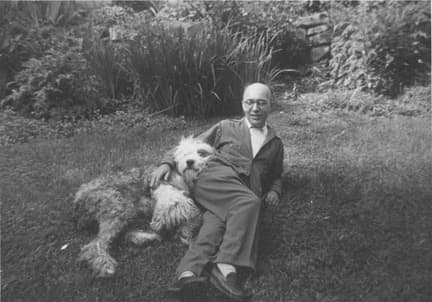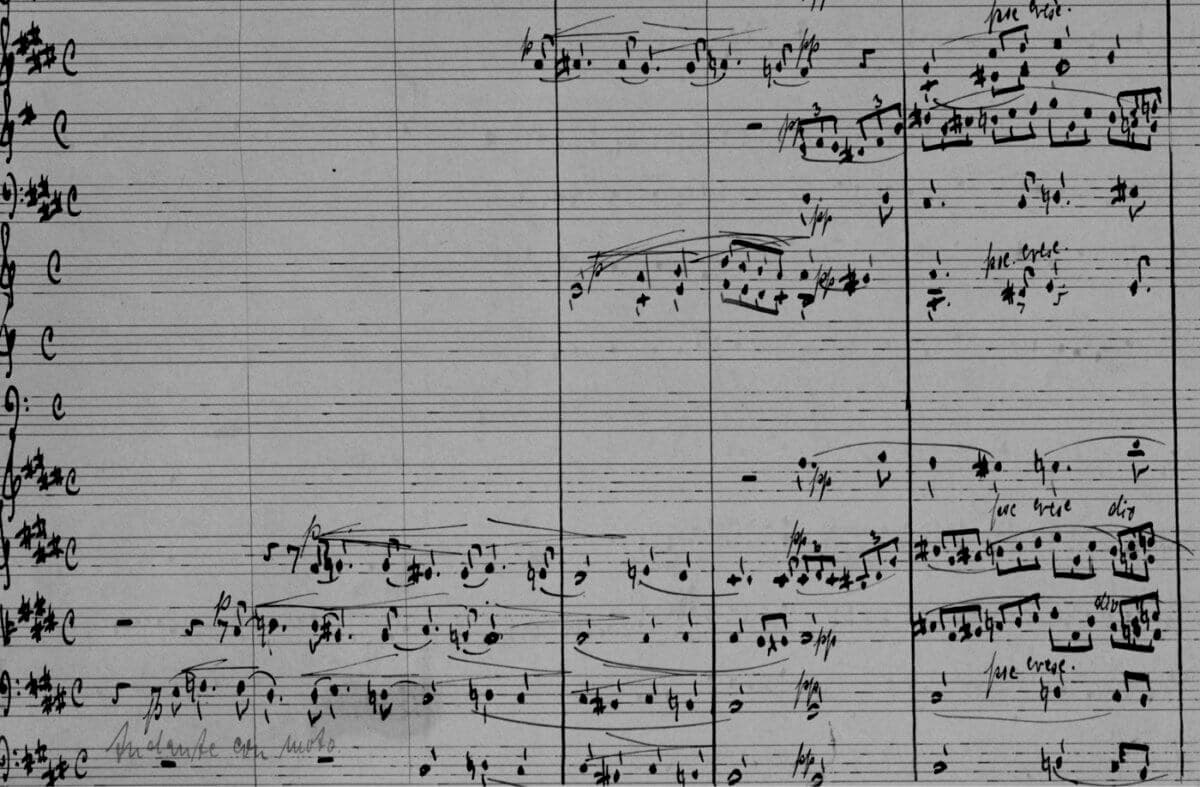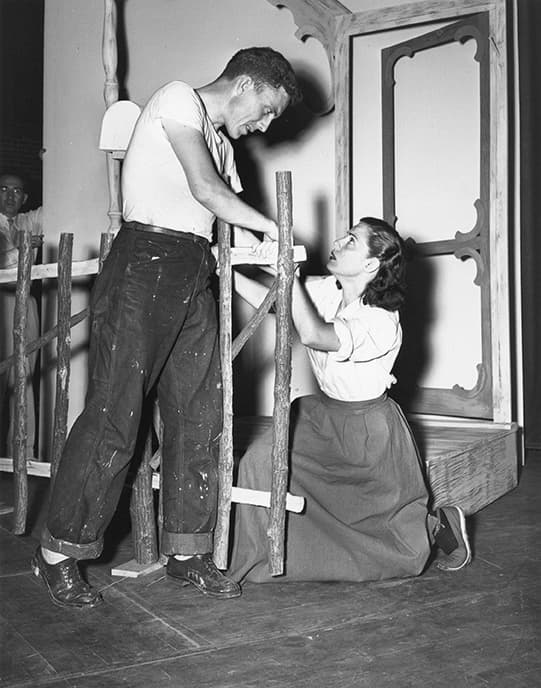In the summer of 1945, Kurt Weill received a commission for a series of short radio operas. Olin Downes, the music critic of The New York Times, and a businessman named Charles McArthur, envisioned a combination of the old English ballad opera with American folksongs and ballads.

Kurt Weill with his Old English Sheepdog named Wooly at Brook House, ca. 1948
Weill engaged the help of the young dramatist Arnold Sundgaard, and the radio opera Down in the Valley was written between August and November 1945. A scholar writes, “For various reasons, however, it did not reach transmission and the entire radio opera project never materialized.” Several years later, in January 1948, the composer received a request from the School of Music at Bloomington, Indiana. Hans Busch, son of the Dresden Opera conductor Fritz Busch, was director of the Opera Workshop at the University, and he was looking for a work suitable for his group. The work was intended for a non-professional group and would require only simple staging.
Kurt Weill: Down in the Valley – Prelude (New York University wind players; Westphalian Chamber Philharmonic; Willi Gundlach, cond.)
Kurt Weill: Down in the Valley – Scene 1: Down in the valley, valley so low (Donald Collup, baritone; Fredonia Chamber Singers; Dortmund University Chamber Choir; New York University wind players; Westphalian Chamber Philharmonic; Willi Gundlach, cond.)

Weill was eager to take on the project, and he remembers the “astonishingly successful experiences I had had some years previously in Europe with one of the school operas I had written, and it seemed to me that the piece we had written for Mr. Downes’ radio programme could easily be transformed into an American school opera. Sundgaard and I went to work again. We changed the original radio play to a musico-dramatic form, about twice as long as the original, with new scenes, new song texts, and new music as well as completely new orchestration suitable to the special requirements of school orchestras. This is the folk opera Down in the Valley.” Weill further explained in the preface of the vocal score, that the work “can be performed wherever a chorus, a few singers, and a few actors are available. In colleges and universities, it should be produced through the combined efforts of both the drama and music departments.”
Kurt Weill: Down in the Valley – Scene 5: There’s a little black train a-comin (Marc Acito, tenor; Ilana Davidson, soprano; Donald Collup, baritone; Fredonia Chamber Singers; Dortmund University Chamber Choir; Linda Mabry, piano; Klemens Koerner, piano; New York University wind players; Westphalian Chamber Philharmonic; Willi Gundlach, cond.)
Kurt Weill: Down in the Valley – Scene 6: I was glad you said I could walk home (Marc Acito, tenor; Ilana Davidson, soprano; Linda Mabry, piano; Klemens Koerner, piano; New York University wind players; Westphalian Chamber Philharmonic; Willi Gundlach, cond.)

Kurt Weill’s “Down in the Valley”
Premiered at the School of Music at Bloomington, Indiana, on 15 July 1948, the plot narrates the love story of Brack Weaver and his sweetheart Jennie Parsons. Brack is awaiting his execution in a Birmingham jail for the supposed slaying of Thomas Bouché. However, he escapes jail to find Jennie, and in a series of flashbacks we learn that they met at a church service. Too shy to declare his love, he invites her to a dance. Her parents strongly object since she is promised to the shady businessman Thomas Bouché. Jennie and Brack do meet at the dance, but a drunken Bouché pulls a knife and is killed in the ensuing melee. Brack is apprehended, imprisoned, and condemned to be hanged. As the flashback ends, dawn is approaching, and Brack surrenders willingly in the knowledge that Jennie will always care for him. Much of the music is generated from a single folksong, “Down in the Valley,” which is actually heard 19 times.
Kurt Weill: Down in the Valley – Scene 8: I got a gal at the head of the holler (Donald Collup, baritone; Fredonia Chamber Singers; Marc Acito, tenor; Ilana Davidson, soprano; James Mabry, vocals; Donald P. Lang, vocals; Linda Mabry, piano; Klemens Koerner, piano; Dortmund University Chamber Choir; New York University wind players; Westphalian Chamber Philharmonic; Willi Gundlach, cond.)
Kurt Weill: Down in the Valley – Scene 9: Brack Weaver he loved her (Donald Collup, baritone; Marc Acito, tenor; Ilana Davidson, soprano; James Mabry, vocals; Donald P. Lang, vocals; Linda Mabry, piano; Klemens Koerner, piano; Fredonia Chamber Singers; Dortmund University Chamber Choir; New York University wind players; Westphalian Chamber Philharmonic; Willi Gundlach, cond.)

Premiere performance at Indiana University, 1948
Stephen Hinton writes, “the disjunction between the simplicity of the melodic material and the refinement of its compositional working is striking: Weill draws on an array of compositional idioms and techniques to vary each repetition of the principal tune in accordance with the requirements of the drama.” As narrator, chorus, and soloists alternate in the flow of the music action, Weill deliberately emphasizes the idea of a folk opera, using modest texture and an original American idiom. The performance on 15 July 1948 was a great success, and on the occasion of the New York performance, Weill proudly reports to his parents, “My folk opera Down in the Valley, which has already been performed in over 100 towns in America… has been assessed as a work that will go down in history as the fountainhead of American opera. You can imagine what that means to me.” In its first nine years Down in the Valley is reported to have received more than 1600 productions and some 6000 performances, “making it, after Die Dreigroschenoper, Weill’s most frequently performed work.”
For more of the best in classical music, sign up for our E-Newsletter
